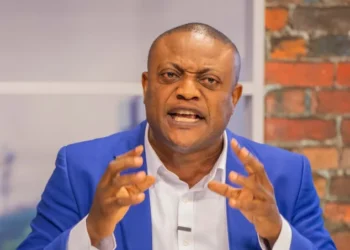In the contemporary music landscape, where visual storytelling has become as significant as auditory experience, the absence of a music video is perceived as a professional misstep for artists.
While the argument that music should stand on its own merits without the need for visuals has some validity, the reality of the industry today suggests otherwise.
Media personality, MC Portfolio responded to Bullgod’s claim that music videos are no longer relevant. He shared his concerns regarding the importance of music videos in contemporary artistry.
He highlighted that in a competitive market, the absence of visually engaging content can hinder an artist’s image, suggesting that it does not effectively position them as serious creatives in the eyes of potential investors.
In an exclusive interview with The Vaultz News, Ghanaian artist, Isaac Sarfo Sowah, popularly known as Da Saint, added his voice to MC Portfolio’s response to Bullgod’s claims.
According to him, he disagrees with Bullgod’s claims. “This is because music videos tell the story behind the song, and they make the work complete,” he said.
Music consumption is intrinsically linked to visual media in an age dominated by platforms like YouTube, TikTok, and Instagram.
The rise of these platforms has shifted how audiences engage with music; they often expect a visual accompaniment to songs.
Music videos are a powerful storytelling tool, allowing artists to convey deeper meanings and emotions that might not be captured through audio alone.
However, Da Saint shared his thoughts on the future of full-length music videos, citing an example.
“I was on Facebook watching short videos done by people, and I chanced on a particular video that had a song playing in the background, I quickly screen recorded and Shazamed it and got the name of the artist and song title, so it really helps in terms of promoting the song, so if you asked again, I would say the future holds a lot.”
Da Saint
Without a music video, an artist risks being overlooked in a crowded marketplace where visuals play a crucial role in capturing attention.
The lack of a video leads to a perception that the artist is not fully utilizing available resources to promote their work.
On the relationship between music videos and other aspects of an artist’s branding, Da Saint mentioned that “it helps us to know the artist by face, how the artist brands himself, and understand the narrative of the song, etc.”
In the music industry, branding is everything. Artists are not just musicians; they are brands that need to resonate with their audience.
A music video allows artists to express their identity, style, and message in a way that audio alone cannot. It provides a canvas for creativity, enabling artists to showcase their personalities, aesthetics, and narratives.
In a world where audience engagement is crucial, failing to produce a music video is seen as a lack of commitment to one’s brand.
Moreover, music videos often go viral, which exponentially increases an artist’s visibility. In contrast, a song without a video struggle to gain traction, limiting its potential audience.
In a digital age where content is king, the absence of a music video hinders an artist’s ability to reach new fans and grow their audience.
Industry Standards, Expectations in Music Videos

The music industry has evolved, and with it, the expectations surrounding artist promotion. Major labels and industry professionals often look for a comprehensive marketing strategy that includes music videos.
For emerging artists, this is particularly detrimental. They find it challenging to secure management, label deals, or even booking opportunities if they do not have a visual representation of their work.
In essence, a music video has become a standard expectation in the industry, and failing to produce one is interpreted as a lack of seriousness or ambition.
However, Da Saint revealed that shooting a quality music video shows how much work, time, and finance an artist has invested in his craft.
“For example, Sarkodie, when you watch his music videos, you can tell from the camera quality, location, branding, even the people starring in it says it all. When he releases a music video, the fans go like ‘This guy is too dope.’ So shooting a quality music video helps shape the industry and the individual to grow.”
Da Saint
Music videos are a medium for artistic expression and innovation. They allow artists to collaborate with directors, choreographers, and visual artists, leading to unique and creative outputs that enhance the song’s message.
Bullgod mentioned that money might be wasted on music videos. Responding to the claims, Da Saint responded in the negative.
“Can you build a house without painting it?? No, I don’t agree with him. Once a song is released, a music video must follow. It’s never a waste to invest in music videos.”
Da Saint
In a saturated market, artists must find ways to differentiate themselves. A compelling music video sets an artist apart from their peers, showcasing their unique style and approach to music.
Without a music video, an artist blends into the background, struggling to stand out in a sea of talent.
The competition is fierce, and those who leverage visual media effectively are more likely to capture the attention of both fans and industry professionals.
While an artist finds success without a music video, the reality is that in today’s music industry, not having one is seen as unprofessional.
Music videos are no longer just an optional add-on; they are an integral part of an artist’s brand, marketing strategy, and overall engagement with their audience.





















